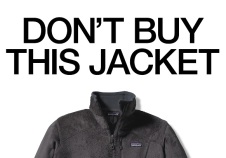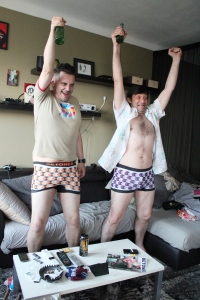 Have a brand and want to charge a premium? – Then you better stop selling and start to woo your target audiences. Because selling is the opposite of seducing. – It’s not sexy. And that creates a natural conundrum for brands that want to be be esteemed, since they, of course, need to do both. This greatly impacts how modern Prestige brands approach to communication which is very different from that of mass marketers.
Have a brand and want to charge a premium? – Then you better stop selling and start to woo your target audiences. Because selling is the opposite of seducing. – It’s not sexy. And that creates a natural conundrum for brands that want to be be esteemed, since they, of course, need to do both. This greatly impacts how modern Prestige brands approach to communication which is very different from that of mass marketers.
“Ueber-Brands” – as we call the best of them – ‘Un-Sell’, as we uncover in our book. ‘Un-Selling’ is about creating proximity while maintaining a distance. Putting yourself out on a stage yet never revealing too much. Evoking more than you are saying – to protect your aura and a sense of mystery. Talking in artfully crafted and refined codes to make sure only those in the know will understand. Being un-apologetically confident, often bordering on the arrogant to project strength and pride. And, more often than not, Un-Selling means being silent and pulling back when and where everyone else is shouting and peddling their wares. – Because after all ‘silence is golden’ and it is the absence of the loved one which makes the heart grow fonder.
Below we will look at each of these tactics in a bit more depth. Or you can just watch this video, if you are lazy:
An alluring mix of pride and provocation
There’s an old saying in the prestige industry: “With every millimeter the mouth opens (towards a smile), the price point goes down a notch.” Prestige brands aren’t there to endear us, they must impress us. These brands will not be bossed around by anybody—including their consumers. Yes, “the consumer is not boss” here! Traditionally, this has often been done through an unapologetic display of confidence or even arrogance – just look through any of the glossy fashion or luxury goods magazine and you will see what we mean.
Provocation has been another tool of the trade, particularly in the premium fashion industry, but is also increasingly exposed as blunt and a cheap trick. Today’s Ueber-Brands follow a more calibrated approach, mixing pride and provocation by blending both in ever new and intriguing ways – often with a dose of humor.

Betones provokes with it’s quirky Japanese take on British Blokes
A great example is Below 42 a premium vodka from New Zealand. Its success is almost entirely built on an audacious spirit (no pun intended), starting from its politically incorrect print ads to the self-mocking tone in which it keeps building its legend and promoting its brand today. One of its ads reads, “Below 42, the vodka that has absolutely nothing going for it.”
Another “American celebrities adopt our vodka like it was a Third World child.” Here Below 42 turns “refined” on its head (quite literally with its head-standing kiwi icon). The company eschews anything remotely “cultured” in the conventional sense and go for outright counter-culture, starting its own tradition: proud in its product and provenance yet unbending in its attitude, iconoclast and standard setting at the same time.
2. The celebrity as a fan, not an endorser
Prestige brands crave a good endorsement, but they are careful to not get upstaged while enjoying the uplift. They often turn the relationship between brand and endorser on its head, presenting the celebrity as the one paying tribute to the brand or, at least, its humble user.
There are various ways to do this. One is the brand and celebrity partnering for a cause, for example the Montblanc campaign for literacy, MAC’s Viva Glam lipstick and its slew of famous ambassadors or the Mandarin Oriental’s “She/He is a fan” campaign, which makes a modest donation to the celebrities’ favorite good cause for volunteering, rather than “pay” her or him. Some of the commercials, which are like “mini-movies,” blur the roles when identifying the star. Is it Nicole Kidman, now Gisele Buendchen, or Chanel No. 5? Is it Charlize Theron (and Marlene Dietrich, Marilyn Monroe) or Dior J’Adore in those iconic perfume ads?
The brand becomes the star or director rather than supplicant. The ultimate in these power-play strategies, however, is when the brand outshines who should be the hero— or even playfully puts him down, like Nespresso does in its longstanding, light-hearted campaigns featuring George Clooney (in Europe) or Penelope Cruz (in the US). In those ads, the star is overlooked, as a cup of Nespresso takes the limelight. Interestingly, Nespresso said that Clooney was elected by Nespresso Club members as their ambassador rather than hired by their marketing department.
3. Avert the overt
The late artist Keith Haring once said: “If there’s no mystery, there’s only propaganda,” and he certainly knew a thing or two about culture, communication, and commerce. And that pretty much sums up the third way of building prestige: Ueber-Brands play “hide and seek” more often than they do a “show and tell.”
Mass brands make sure their brand message is didactic, loud, and clear, but modern prestige brands tend to stay veiled, creating an aura without over-promoting themselves. Yes, Mercedes will eventually talk miles per gallon, technology, or lease prices, but its spots will focus on celebrating the icon its car is first and foremost. Just recall the Superbowl XX ad where all the iconic models present and past congregate for a celebration of self.
 There are three reasons for this:
There are three reasons for this:
- Overt selling is far too vulgar to make a superior impression.
- Our imagination is much better at creating aspiration than anything else. Prestige brands need to get our right brain engaged and make sure the left stays out of it as much as possible as critical thinking would only get in the way of making us believe.
- Subtlety and esoteric references are much better equipped to distinguish class from mass in a world where wealth and branded consumption is widespread. You will not see a Bottega Veneta product openly branded, yet the weave will immediately signal to those in the know. Amateurs recognize a Berlutti shoe and its connoisseur wearer by the unique Windsor way it was tied (and both can be proud of “knowing” beyond just “having”).
4. Be art-full
There’s always been a close connection between the art world and many expensive brands. Both deal with products creatively inspired and exceptionally crafted. They build their value to a large degree on limited supply and share a highly discriminating and moneyed audience. They also complement each other, one supporting the other through deeper pockets, the other validating the one with a sense of sublime and sophistication. This embrace has gotten more intense, just think of the heavily commercialized art circuit parties from Basel to Miami, London to New York to Berlin or Hong Kong.
Most interesting, however, are not the age-old sponsorship deals or the boom of company museums like the new, Gehry-designed museum by Fondation Louis Vuitton in Paris. What’s noteworthy are the innovative and integrative forms of cooperation and communication.

Renova – Nuit Blanche Toronto. Photo by Stephanie La Civita (link)
We are almost used to a fashion house releasing mini movies like Prada did with “A Therapy” by Prada shot by Roman Polanski. The surprise entrant last year, though, was that eternally expensive toy block Lego with its critically acclaim eponymous blockbuster movie (again no pun intended).
On the product side, fashion houses also lead the way with co-created collections like Louis Vuitton’s 2001 super-successful graffiti bags by designer-artists Stephen Sprouse. Today, you will find limited-edition art on bottles from Evian (water) to Kiehls (skin care), on BMWs (Art Cars) or MINIs or even luxury toilet paper (Renova).
5. Be the media
We are talking about the brand as content machine and community magnet. Digital media, in particular, have been an enabler to create highly controlled, super-efficient brand experiences and engagements that never seem too eager or too pushy.
Two brands that have made this their premier marketing vehicle and styled their brands as media outlets rather than mere product venues are Red Bull and Net-a-Porter. The first may not seem prestige, but it certainly is if you look at its considerable price premium. And it has grown into a media empire. Red Bull Media House offers anything from events to games to apps to TV to print, largely sourced from the collaborations and sponsorships Red Bull is doing, thus not only being a lighthouse for innovative brand and community building, but also providing great opportunities for secondary usage and income streams.
Net-a-Porter was built to be “the world’s premier online luxury fashion destination” and was from the beginning not just an online shopping site but much more a magazine around fashion and luxury that also allows you to buy things. Luring people in with great editorial content and then allowing them to shop, if they come across something they like.
Culture, commerce, content, and convenience are all fused in perfect symbiosis. And that’s done in a way that never undermines the superior standing and status potential of the brand, rather elevates it to cultural icon with omni-power. A true Ueber-Brand in other words.
This post is derived from an article we contributed to MarketingProfs.com earlier this year and based on our book “Rethinking Prestige Branding – Secrets of the Ueber-Brands“. You can find more information on Un-Selling – including many case studies – in the book.



Pingback: Un-Selling – The Superiority of Seduction | Ueber-Brands™